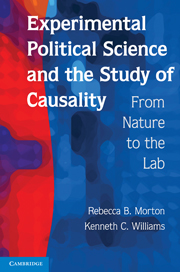Book contents
- Frontmatter
- Contents
- Acknowledgments
- I INTRODUCTION
- II EXPERIMENTAL REASONING ABOUT CAUSALITY
- 2 Experiments and Causal Relations
- 3 The Causal Inference Problem and the Rubin Causal Model
- 4 Controlling Observables and Unobservables
- 5 Randomization and Pseudo-Randomization
- 6 Formal Theory and Causality
- III WHAT MAKES A GOOD EXPERIMENT?
- IV ETHICS
- V CONCLUSION
- References
- Author Index
- Subject Index
6 - Formal Theory and Causality
Published online by Cambridge University Press: 05 June 2012
- Frontmatter
- Contents
- Acknowledgments
- I INTRODUCTION
- II EXPERIMENTAL REASONING ABOUT CAUSALITY
- 2 Experiments and Causal Relations
- 3 The Causal Inference Problem and the Rubin Causal Model
- 4 Controlling Observables and Unobservables
- 5 Randomization and Pseudo-Randomization
- 6 Formal Theory and Causality
- III WHAT MAKES A GOOD EXPERIMENT?
- IV ETHICS
- V CONCLUSION
- References
- Author Index
- Subject Index
Summary
What Is a Formal Model?
We turn in this chapter to the Formal Theory Approach (FTA) to causality. The key difference between FTA and the Rubin Causal Model (RCM) is that a formal model serves as the basis for the causal relationships studied. To understand what we mean by FTA, it is useful to define what we mean by a formal model. We define a formal model as a set of precise abstract assumptions or axioms about the data generating process (DGP) presented in symbolic terms that are solved to derive predictions about that process. These predictions are of two types: point predictions and relationship predictions. Point predictions are precise predictions about the values of the variables in the model when the model is in equilibrium, whereas relationship predictions are predictions about how we may expect two variables in the model to be related. Defining what is meant by whether the model is in equilibrium can vary with the model as well; different formal models rely on different equilibrium concepts, which is something that we investigate later in Section 6.5.4. Some of these relationship predictions may be predicted to be “causal” in that changes in one variable “cause” changes in the other variable.
Definition 6.1 (FormalModel): A set of precise abstract assumptions or axioms about the DGP presented in symbolic terms that are solved to derive predictions about the DGP.
Definition 6.2 (Point Prediction of a Formal Model): A precise prediction from a formal model about the values of the variables in the model when the model is in equilibrium.
- Type
- Chapter
- Information
- Experimental Political Science and the Study of CausalityFrom Nature to the Lab, pp. 196 - 250Publisher: Cambridge University PressPrint publication year: 2010



